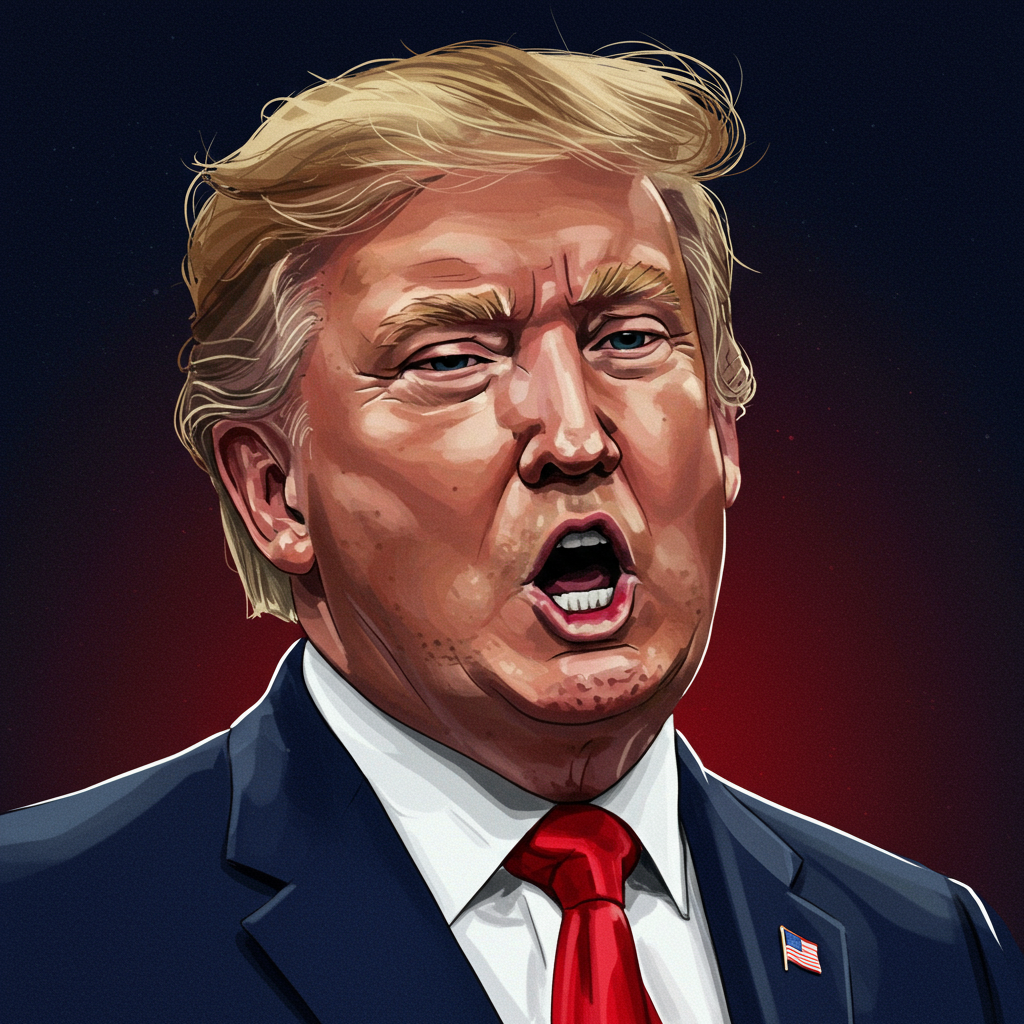In a sudden move shaking North American economic relations, U.S. President Donald trump announced the immediate termination of all trade discussions with Canada. The decisive action, communicated via his Truth Social platform, cites Canada’s controversial new digital services tax (DST) as the sole provocation for ending negotiations. This development casts significant doubt on the future of trade between the two close allies and major economic partners.
President Trump described Canada’s digital levy as a direct and blatant “attack on our country.” He labeled the measure an “egregious Tax.” Citing this new policy, Trump declared, “we are hereby terminating ALL discussions on Trade with Canada, effective immediately.” The announcement signals a sharp escalation in ongoing trade tensions between Washington and Ottawa.
The Digital Services Tax at the Heart of the Dispute
Canada’s digital services tax became law in June 2024. It officially came into force on June 28. This tax imposes a 3% levy. It applies to revenue large companies generate from engaging with online users physically located within Canada.
To be subject to the tax, businesses must meet certain conditions. These include generating global revenue exceeding 750 million euros (about CAD $1.1 billion) and revenue from Canadian sources exceeding CAD $20 million ($14.6 million USD). The tax targets income from online marketplaces, advertising services, social media platforms, and certain user data sales.
Payments for this tax were scheduled to begin collection shortly after Trump’s announcement. Critically, the tax applies retroactively to revenue earned since 2022. Initial estimates suggested this could result in a bill of around $2 billion USD for affected U.S. tech firms like Amazon, Google, Meta, Uber, and Airbnb. The Canadian government views the tax partly as a way for foreign digital giants to contribute financially. This contribution could potentially support domestic Canadian film, television, and music production.
Canada’s Stance on the Digital Levy
Despite concerns raised by businesses and warnings of potential U.S. retaliation, Canada chose to proceed with the tax’s implementation. Just days before Trump’s announcement, Canadian Finance Minister Francois-Philippe Champagne had suggested the issue might find resolution within broader trade discussions. These talks were reportedly progressing well towards a potential deal by mid-July.
The Canadian government has maintained its position on the DST. They argue it is a domestic matter. Political science experts note that the tax legislation was signed into law a full year before its implementation date. This suggests the U.S. was aware of the plan for a considerable time.
Trump’s Swift Retaliation and Tariff Threat
Following his declaration of terminating trade talks, President Trump issued a further threat. He stated his administration would inform Canada within the “next seven day period” of a new tariff rate. This rate would apply to Canada for doing business with the United States.
Trump characterized Canada as “a very difficult Country to TRADE with.” He repeated a long-standing grievance. Trump claimed Canada levies tariffs as high as 400% on U.S. dairy products. This suggests the dairy issue remains a point of contention alongside the new digital tax. The specific tariffs Trump intends to impose remain unknown.
Escalation in a Tumultuous Relationship
This recent development is seen as a significant escalation in U.S.-Canada trade relations under the Trump administration. The relationship has been described as a “roller coaster” since his return to the White House. Earlier this year, Trump imposed new tariffs on Canadian goods. These included steel, aluminum, and some auto parts. Canada responded with retaliatory tariffs on American exports. Many of these previous tariffs reportedly remain in effect.
President Trump and Canadian Prime Minister Mark Carney had met previously. A White House meeting occurred in May. Discussions continued at the G7 summit in Alberta just a week before the trade talk termination. At that summit, reports indicated an agreement to work towards a new trade and security deal. A target deadline of mid-July was reportedly set. Trump’s announcement effectively scuttles this timeline and the ongoing negotiations.
Business organizations on both sides of the border have voiced concern over the DST and potential retaliation. The Canadian Chamber of Commerce called the tax “self-defeating.” They advised Ottawa to scrap it due to the risk of U.S. action and increased costs. The American Chamber of Commerce in Canada warned that Washington clearly viewed the tax as a “provocation.” They also urged Canada to cancel it. The Business Council of Canada suggested suspending the DST. They proposed using its potential elimination as leverage to get the U.S. to remove its existing tariffs.
Economic Impact and Market Reaction
The abrupt halt in trade talks and threat of new tariffs triggered an immediate market reaction. The U.S. dollar gained strength against the Canadian dollar. It rose by 0.7% following the news.
The stock market also saw shifts. The benchmark S&P 500 index had reached an all-time high earlier in the day. However, it pared back these gains significantly after Trump’s announcement. Market experts note that investors prefer stability in trade relations. Uncertainty tends to dampen market enthusiasm.
Economists largely agree that imposing new tariffs on Canadian goods would harm both the U.S. and Canadian economies. Tariffs increase costs for businesses. These costs are often passed on to consumers through higher prices.
Canada is the United States’ second-largest trading partner. The trade volume is substantial. Last year, Canada imported $349.4 billion worth of U.S. goods. Canada exported $412.7 billion to the U.S. The two economies are deeply integrated. Disrupting this relationship through tariffs could have widespread negative consequences. Canada is the largest importer of American exports. It ranks among the top three sources of U.S. imports.
Expert Perspectives on Trump’s Strategy
Experts interpret Trump’s action in various ways. Some see it as a significant escalation. Vina Nadjibulla, a research and strategy expert, called it an “escalation.” However, she also noted it’s a tactic Trump has used before. She suggested Canada might need to find a quiet “off-ramp.” This would involve seeking a solution behind the scenes without appearing to concede to Trump’s public demands. Coordination with the European Union and other partners facing similar pressure from the U.S. on digital taxes could be key.
Rachel Ziemba, an adjunct senior fellow, found the declaration “unfortunate but not surprising.” She viewed it partly as a “scare tactic.” This tactic could be aimed at the European Union. The U.S. is also negotiating trade deals with the EU that involve digital taxation issues. Daniel Beland, a political science professor, suggested Trump’s timing was deliberate. Waiting until just before the tax collection began creates “drama.” This fits within the context of uncertain ongoing trade negotiations.
The U.S. tech industry has supported the administration’s stance. Matt Schruers, CEO of the Computer & Communications Industry Association, expressed appreciation for the “decisive response.” He characterized Canada’s DST as a “discriminatory tax on U.S. digital exports.”
Interestingly, context shows a complex picture in the U.S. Congress. Previously, 21 members warned Trump that Canada’s DST could inspire other “discriminatory cash grabs.” However, congressional Republicans recently removed a proposed “revenge tax” provision from a major tax bill. This provision would have allowed the U.S. to tax companies from countries imposing what it deemed “unfair foreign taxes.” This removal reportedly occurred at the Treasury Secretary’s request.
Frequently Asked Questions
What caused the U.S. to terminate trade talks with Canada?
United States President Donald Trump announced the immediate termination of all trade discussions with Canada. The primary reason he cited was Canada’s implementation of a new 3% digital services tax (DST). This tax applies to revenue large businesses, including American tech companies, earn from online users within Canada. Trump called the tax a “direct and blatant attack” on the U.S. and stated it was the sole reason for ending negotiations.
How does Canada’s digital services tax work, and who does it affect?
Canada’s digital services tax imposes a 3% levy on revenue generated by large companies from online users located in Canada. It applies to businesses with global revenue over approximately $1.1 billion CAD and Canadian revenue over $20 million CAD. This includes major U.S. tech platforms earning money from online advertising, marketplaces, social media, and user data in Canada. The tax became effective June 28, 2025, applies retroactively to 2022, and collection was set to begin shortly after Trump’s announcement.
What potential consequences could arise from the breakdown in US-Canada trade discussions?
The termination of talks introduces significant uncertainty. President Trump threatened to impose new tariffs on Canadian goods within seven days. Economists warn that new tariffs could harm both economies by increasing costs for businesses and consumers. The move also jeopardizes ongoing negotiations towards a new trade framework, potentially impacting the future relationship ahead of the USMCA renegotiation timeline. Experts view it as an escalation that could further strain relations between two major trading partners.
Uncertainty Hangs Over Future Trade
The sudden halt in U.S.-Canada trade discussions creates considerable uncertainty. A previously reported deadline for a new trade agreement, set for mid-July, now appears impossible to meet. The United States-Mexico-Canada Agreement (USMCA), negotiated during Trump’s first term, is already due for renegotiation by next year. The current breakdown complicates efforts to establish a smooth trade framework moving forward.
Canada has indicated it intends to continue engaging in negotiations, despite Trump’s public stance. However, the lack of a clear path to resume formal talks, coupled with the threat of new tariffs, leaves the future of one of the world’s largest bilateral trading relationships in doubt. Businesses and consumers in both countries could face negative impacts if trade tensions escalate further. The resolution of this dispute hinges on finding an “off-ramp” that addresses the core disagreements over digital taxation and market access.
Word Count Check: 1107



